
Wolf spiders are members of the family Lycosidae. They are robust and agile hunters with excellent eyesight. They live mostly in solitude, hunt alone, and usually do not spin webs. Some are opportunistic hunters, pouncing upon prey as they find it or chasing it over short distances; others wait for passing prey in or near the mouth of a burrow.

The hobo spider is a member of the family of spiders known colloquially as funnel web spiders, but not to be confused with the Australian funnel-web spider. Individuals construct a funnel-shaped structure of silk sheeting and lie in wait at the small end of the funnel for prey insects to blunder onto their webs. Hobo spiders sometimes build their webs in or around human habitations. The hobo spider lays its eggs in September and they hatch during late spring. After the male hobo spider mates it dies.
John Jonah Jameson III is a fictional character appearing in American comic books published by Marvel Comics. The character is depicted as the son of J. Jonah Jameson, and a friend to Peter Parker. He has also been portrayed as the husband of Jennifer Walters / She-Hulk.
"Alias the Spider" is a superhero feature from the Golden Age of Comic Books that appeared in Quality Comics' Crack Comics for nearly three years, starting with issue #1 in 1940. He was created by writer-artist Paul Gustavson.
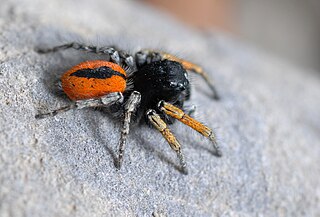
Philaeus chrysops is a species of jumping spider (Salticidae).

The Man-Beast is a fictional character appearing in American comic books published by Marvel Comics.

The Kauaʻi cave wolf spider, also known to local residents as the blind spider, is only known to occur in a few caves in a lava flow with an area of 10.5 km2 (4.1 sq mi) in the Kōloa–Poʻipū region of Kauaʻi, Hawaiian Islands, and only six populations are known to exist. While their nearest surface-dwelling relatives have large eyes, this species has completely lost its eyes. They reach a body length around 20 mm (0.8 in), and are reddish brown and completely harmless to people. Unlike most wolf spiders, it produces only 15 to 30 eggs per clutch. The female carries the egg sac in her mouthparts until the spiderlings hatch.
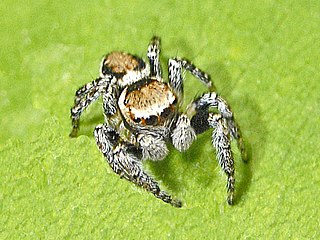
Evarcha falcata is a species of 'jumping spiders' belonging to the family Salticidae.

Dolomedes scriptus is a fishing spider found in the United States and Canada, known as the striped fishing spider. Female spiders can grow to be over 6 cm in legspan. The spider is a pale brown colour with lighter stripes around its legs and a stripe down each side of the body. It is similar to D. tenebrosus.

Plexippus paykulli is a species of jumping spider. It is native to south east Asia but has spread to other parts of the world and globe. In the United States it is called the pantropical jumping spider. It is usually associated with buildings and may be found near light sources catching insects attracted by the light. It is named in honor of Gustaf von Paykull.
Acantholycosa oligerae is a species of wolf spider only known from Primorsky Krai, Russia.

Hogna carolinensis, commonly known as the Carolina wolf spider and giant wolf spider, is found across North America. It is the largest of the wolf spiders in North America, typically measuring at 18–20 mm for males and 22–35 mm for females.

Rabidosa rabida, also known as the rabid wolf spider, is a species of spiders from the family Lycosidae, native to North America. In the United States it is found from Maine to Florida and west to Texas.
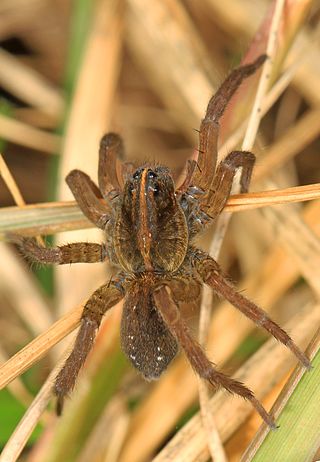
Tigrosa helluo is a species of spider belonging to the family Lycosidae, also known as wolf spiders. T. helluo was formerly known as Hogna helluo before differences between dorsal color patterns, habitat preferences, body structures, etc. were discovered. The species is native to the United States, Canada, and Mexico. It can be found across the eastern half of the United States, primarily in the Northeast and New England, and as far west as Nebraska and Kansas. T. helluo can be found in diverse habitats including woods, marshes, fields, and riparian areas. Typically, members of this species prefer to live in wetter areas as opposed to dry environments. Males tend to live for around a year and females will live for close to two years.

Rabidosa hentzi is a small species of wolf spider found in North America. Most identified specimens were found in Florida, though some have been found in Georgia and Louisiana. Its color is like that of Rabidosa carrana or Rabidosa rabida, but it is distinguished from other Rabidosa species by its paler color and distinct striped pattern on its back. The cephalothorax is a pale brown-yellow color. Between these is a narrower bright yellow to white streak that extends past the eyes. The sternum and abdomen are both pale, though the upper sides are streaked and spotted with brown markings. The eyes are on a black band that extends back, fading into the pale brown. The spermathecae are round and the palea of the pedipalp has a sclerotized cap. Males and females have a similar face and chelicera, though that of males is usually lighter brown. Males will generally have fewer lateral brown markings on the abdomen than females. In the field, it can be distinguished from similar looking species by the thin yellow stripe on its back. Though usually a ground-dweller, due to scopula hairs on the tarsi and metatarsi, it can sometimes climb into shrubs and bushes. It is the only wolf spider that climbs up into the higher vegetation in open woodland.

Pardosa monticola, or pin-stripe wolf spider, is a species of wolf spider found mainly in Europe. It is found in both dry and humid habitats, and up to an altitude of 2000m.
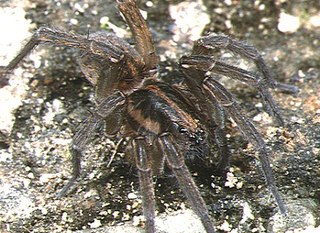
Trochosa aquatica is a species of wolf spider found in eastern Asia which was first described in 1985.

Dicromantispa sayi is a species of mantidfly in the family Mantispidae. It is found in the Caribbean Sea, Central America, and North America.
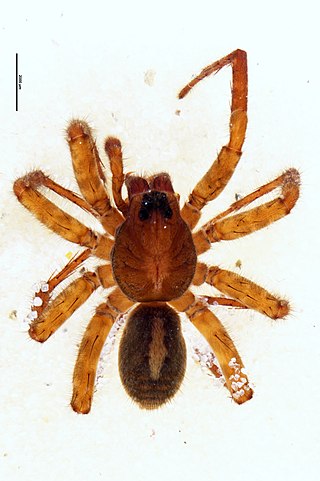
Anoteropsis cantuaria is a species of wolf spider that is endemic to the Canterbury Plains of New Zealand.

Alopecosa fabrilis, known as the great fox-spider, is a species of wolf spider in the family Lycosidae. It is found over much of Europe Eastern Russia, Central Asia and China.


















